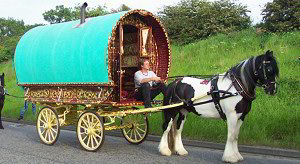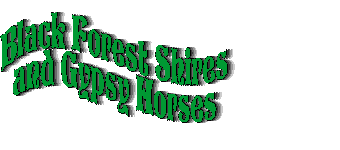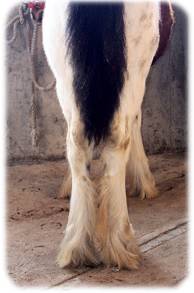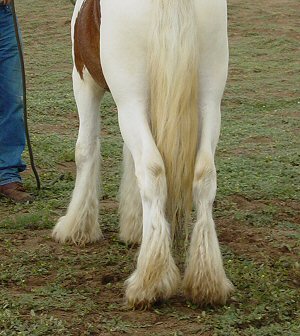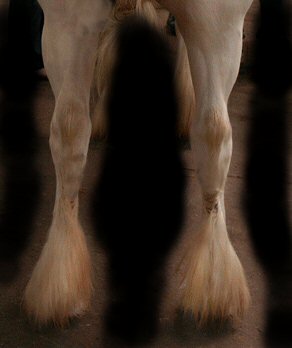|
|
|
Here is some helpful information to help you evaluate the horses you're looking at, or planning to show. We've tried to concentrate on areas where the Gypsy Horse differs from other horses in conformation.Gypsy horses, - a breed, a type, or just some horses that the gypsies have? When we first started importing the Gypsy Horse to North America, we quickly realized there was much to learn about the buying process. The European Gypsy is the world's oldest and most savvy horse dealer, and we weren't going to beat him at the game. However, we knew that by learning as much as we can about the breed, we could work on a level playing field. We already had a solid background in our experience with the Shire horse, and even some familiarity with the differences our two languages presented. Now it was time to learn what the Gypsy man values in the breed, and what sets one individual (horse) apart from another. Along the way, we also learned many "tricks of the trade", and pitfalls to beware of. In the day, many people asked us to tell them about the registry that the gypsies had for these horses. The answer is easy... None. The Gypsy people do not want or need a registry. Even if one was available, it wouldn't have been used. Why??? Well, there are many reasons, and we could write a whole article on that subject alone. Perhaps the most important point to understand is that much of the wealth of a Gypsy family is in the horses they own & breed. The last thing these breeders would want is any organization monitoring their buying, breeding, and selling operations. It's even more of a concern when you realize that in the UK, horse registries are established and regulated by that country's authorities. Many true Gypsies, Romany folk, or travellers, as they are known, don't read nor write, therefore, written records of breeding and ownership were rarely kept. Instead, records are kept much like the Native Americans kept their history records - by word of mouth and stories told. As for the thought that only a registry with papers makes a breed, consider this... British and Irish Gypsy horses have been bred for generation after generation by a small, unique group of people on a few small and unique group of islands just west of Europe. Geography alone goes a long way toward ensuring breed type in this situation. We can tell you that, in spite of the lack of papers, the gypsy cold-blooded horses ("traditional") are a definite type, that breeds true. They have been bred the same way for generation after generation - some lines over 100 years, which is longer than most breed registries have been around. A type that has been bred for generations and that breeds true is the fundamental definition of a breed, papers or not. As any good old-timer will tell you, papers don't make a horse. Just because no one decided to start writing down horse names hundreds of years ago, DOES NOT mean that these horses are any less of a breed than any other. Any one who is realistic will understand that in breeds that have papers, unless there is parentage verification ( a relatively new process) on each horse, that the purity of a line is only as good as the honesty of it's breeder. We came to realize now that we needed to stop thinking like an American, and think more like the Gypsy man. Without the aid of a registry, and knowing that "word-of-mouth" record keeping is subject to error, It was crucial that we understand every aspect of the breed. This is especially important to recognize any "creative selling" tactics that may be directed at us. At the end of the day, our own assessment of the horse was the only thing we could truly depend on. As a rule, we gave little consideration to the purported lineage of a horse. Either it was or was not a good horse, and this fact would not change when we're told who her parents were believed to be. In fact, we purchased many horses from Gypsy men only to learn who the parents were after the fact.
note: This paragraph is not meant to imply that all UK Gypsy horse dealers are crooked. In truth, the men we've dealt with have overall been fair & honest. However, even the most diligent of these breeders may find it difficult to recall and pass along correct information, and can and do make mistakes. What do I look for in a quality Gypsy Horse Throughout this website we refer to the Gypsy Horse as a draft, or draft-type horse. You may come across people who strongly disagree with this description, however their position is usually politically or marketing based, rather than being based on the actual conformation of the breed. The Gypsy horse's heritage includes the Shire and Clydesdale - Traits of which the breed exhibits well. The Gypsy horse was bred and used as a work animal. Without the qualities and conformation of their draft horse influence, they'd never be able to perform the job(s) for which they were bred. Draft horses are used to pull our heaviest loads. Not just because they are bigger, but because their conformation is 'tuned' to that specific job. A quality gypsy horse should have the same basic conformation points as any draft type horse. He/She should have a nice, short back, with a well sloped shoulder angled to compliment the angle of the well rounded croup. A short back is achieved by a sloped shoulder and a nice croup, so you will see these things together. Steep, straight shoulders and rumps are very common faults in these horses and should be avoided. These faults will usually make the horse seem to have a very long back, which is fairly common in heavy type horses. Remember, a short back is a strong back. The head should be in proportion to the size of the animal, with a kind, gentle eye. A roman nose is acceptable, as long as the head isn't too big for the rest of the horse. A small, tidy pony type head (sweet head) is fine as well, as long as it isn't too small for the horse's body. The neck should sit well up on the horse's well sloped shoulder, and be of appropriate length for the body. The legs should be clean and flat in bone and joints, with plenty of bone to support that massive body. There should be no question that this is a DRAFT horse. Hind legs need to have some angle to them, with very straight hind legs being a very common fault in these horses. (you will often find the straight "post legs" in a horse with a very steep croup). The pastern should be at the same angle as the shoulder, and be long enough to give the horse proper flexion and spring when moving. Short pasterns are not only unsightly, but become unsound long before a pastern of proper length. Short pasterns are also very prevalent in gypsy horses of marginal quality, and are indeed the number one fault that causes us to reject a horse that has been presented to us. I would say that about one quarter of gypsy type horses in the USA today have pasterns which are too short for the horse. These have been sold to unsuspecting buyers that don't know what terrible lameness issues that can arise from this fault. Long pasterns aren't common in this breed. As a matter of fact, we can't think of ever seeing a pastern in a gypsy horse that was conformationally too long. Hind legs should have a bit of "set" to them, as any horse bred for pulling should. This is perhaps the most significant difference between the legs of the draft horse and those of a light (saddle) horse. Many people involved with the breed do not understand what "set" is, and it's importance to the overall conformation of the horse. This includes show judges and veterinarians. If a judge or vet is not accustomed to seeing draft horses, they may incorrectly interpret the horse's "set" as a fault. We cannot over-stress the importance of understanding what "set" is, and why it's necessary.
Hair.
Although hair does not make the horse, in order to be a
traditional gypsy cob, you have to have at least as much hair as in a
modern day Clydesdale or Shire horse... In order to be a good one,
you have to have LOTS more hair
than that! The hair should cover the front of the hoof. If it
doesn't, you may have a lovely horse, but it is not a traditional gypsy
cob. On a traditional gypsy cob, the more hair (feather) the
better. There is no such thing as too much. Hair is, of course,
not everything, but without the hair on a traditional gypsy horse, you
cannot have everything. If you have two nice, and identical mares,
and one has twice as much feather as the other, that "heavier" mare is
worth at least twice (much likely more like 4-5 times) what the other mare is worth!
If she's a poorly conformed horse with lots of feather, she still isn't
worth much. The two ingredients to make a *TOP* gypsy horse are
wonderful conformation AND tons of hair. For more complete
description of feather, see the article called "The
Truth About Feather"
Weight of a gypsy horse. We thought we would touch on this, because one of the most common problems we see with new owners of these horses is that they aren't used to the draft horse body type. They often think that a horse is too fat, when, in fact, the horse might be nearly starved. These horses should have a nice, big draft horse barrel. If you can feel ribs, your horse is not in top condition. A gypsy horse in good, show condition will have what we call an "Apple Butt". He should have a nice, rounded behind, with the bone down from the roundness of the behind. If the bone is the highest point on the horse's back or behind, he's way too thin. This is different from the thoroughbred body type, or most light horses. Remember, this is a DRAFT horse.
Examples of Conformation
Here is a convenient diagram outlining various points of conformation to be considered when evaluating the Gypsy Horse. This diagram is available to download and print by Clicking Here. 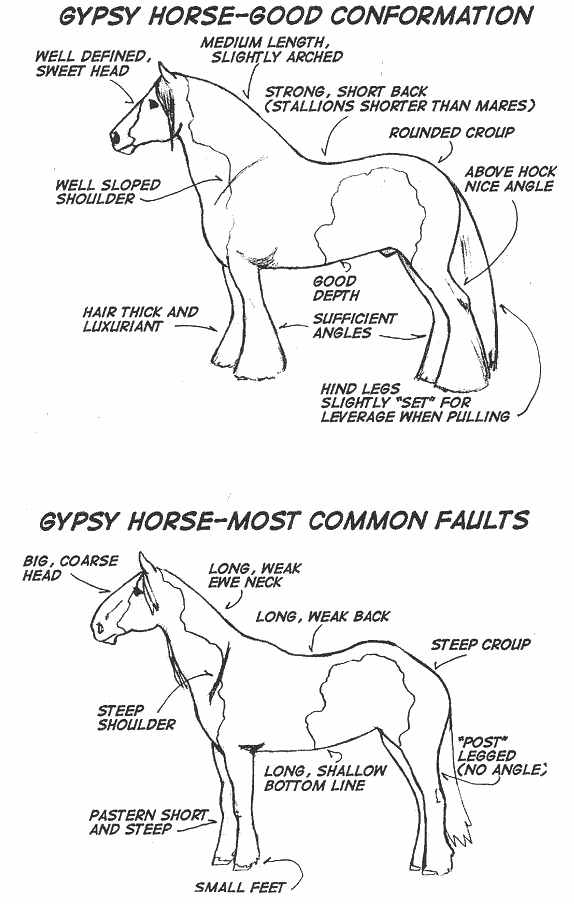
|
|
|
Conformation in the Gypsy Horse
Quality and Conformation considerations
Original article by Christine Bartko
|
|
|||||
|
|
|||||
|
|
